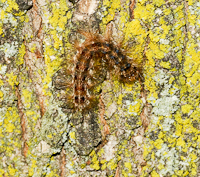|
 The vast majority of deciduous trees can be totally
defoliated for 2 or 3 years in a row and still survive. Otherwise healthy deciduous trees have plenty of
reserves in their trunks and roots to withstand
defoliation. Defoliated trees will put on a new set of
leaves by late July and most will look untouched by late
summer. It does, however, weaken the tree and additional
stresses such as drought, disease or other insects may
cause a few trees to decline and die. The vast majority of deciduous trees can be totally
defoliated for 2 or 3 years in a row and still survive. Otherwise healthy deciduous trees have plenty of
reserves in their trunks and roots to withstand
defoliation. Defoliated trees will put on a new set of
leaves by late July and most will look untouched by late
summer. It does, however, weaken the tree and additional
stresses such as drought, disease or other insects may
cause a few trees to decline and die.
Gypsy moth
caterpillars do not form webbed nests in the
trees.
- Gypsy moth caterpillars may "parachute" from the tree
on a single strand but they do not form a nest. In the
spring, the Eastern tent caterpillar forms webbed nests
in the branches of apple,
crabapple, cherry and related
trees. The fall webworm forms nests at the tips of
branches in autumn.
Gypsy moth caterpillars in the upper Midwest are only active
from about the first week of May until about the first
week of July.
- Fortunately, the caterpillars are only feeding for
about 6 weeks. They are extremely small and stay at the
top of the tree for the first few weeks. Most people
will not notice them until they reach a length of about
12 inches and begin crawling down the tree during the
day and back up to feed in the evening.
The vast majority of the damage is done during the last
2 or 3 weeks of the caterpillar stage.
-In that last couple of weeks of feeding the
caterpillars consume large quantities of leaves. This is
why tree banding techniques may be effective in
protecting small numbers of trees in a home landscape.
Gypsy moth caterpillars tend to follow a long-term
cycle.
- Although it may vary from location to location, it
appears that the gypsy moth populations increase and
then explode into peak numbers for 2 or possibly 3
years. When populations are high, the caterpillars
become stressed and a naturally occurring virus infects
them. The pest then goes into a decline for 6 or 7 years
before increasing again.
Gypsy moth will probably be with us for the foreseeable
future.
- Currently, there is no way to eradicate this pest which
was introduced into America in the late 1800's. In areas
where the infestations are serious, aerial spraying of
large acreage of trees is sometimes used to suppress the
populations. However, only natural predators and disease
ultimately reduce populations.
A few major points to remember about gypsy moth include:
1. Many
pesticides are labeled for use against gypsy
moth caterpillars. The pest is relatively easy to kill,
the major problem is that they tend to attack large
trees. This makes it difficult to deliver sprays to
where the caterpillars are feeding. Usually, commercial
spray equipment or aerial sprayers are necessary. On
small trees such as
crabapple or small oaks, homeowners
may be able to make applications themselves.
2. The biological spray, Bt, (Bacillus thuringiensis)
sold as Dipel, Thuricide, etc. is often used. This is an
excellent insecticide because it only kills caterpillars
and does not bother other wildlife or people. However,
it MUST be used when the caterpillars are young (less
than 1.5 inches long). It does not work well on larger
caterpillars.
3. Tree banding techniques can be effective. Several
techniques are outlined in the bulletin and they work
well at preventing defoliation of individual trees in a
home landscape. They do not work well in woodlot
situations. Banding may be used starting about early
June when the caterpillars begin moving down the tree
during the day to hide and back up to feed at night.
There are several types of bands commercially available.
Some have the sticky material already on them while
others are slippery and do not allow the caterpillars to
crawl back up the tree.
Remember - DO NOT APPLY TANGLE FOOT, AXEL GREASE or
OTHER SUCH MATERIALS DIRECTLY TO THE BARK OF THE TREE.
This will leave a permanent stain on the bark. Put tree
wrap on first and then put the tangle foot on the wrap
rather than onto the bark.
5. Gypsy moth caterpillars are only active from early
May to late June or early July. They then pupate and 10
days later emerge as moths. People should not be
spraying after the first week of July. Also, gypsy moth
traps do not control gypsy moth. They only catch the
males and do not catch enough of them to prevent mating
from occurring. The traps are only good for monitoring
the activity of gypsy moths in the area.
6. Unscrupulous people may take advantage of homeowners
when gypsy moth numbers are high. A few con games have
been reported in connection with gypsy moth problems.
People will approach homeowners when the trees are
defoliated and tell them that their trees are dead. They
will then cut the live trees down and haul them away for
a fee. Other people have been offering a "preventative"
spray to be applied in August. This does absolutely no
good but, when the trees refoliate (which they will do
naturally anyway) it looks as if the spray did
something.
|



